Welding Technology Automatic and robotized applications of welding


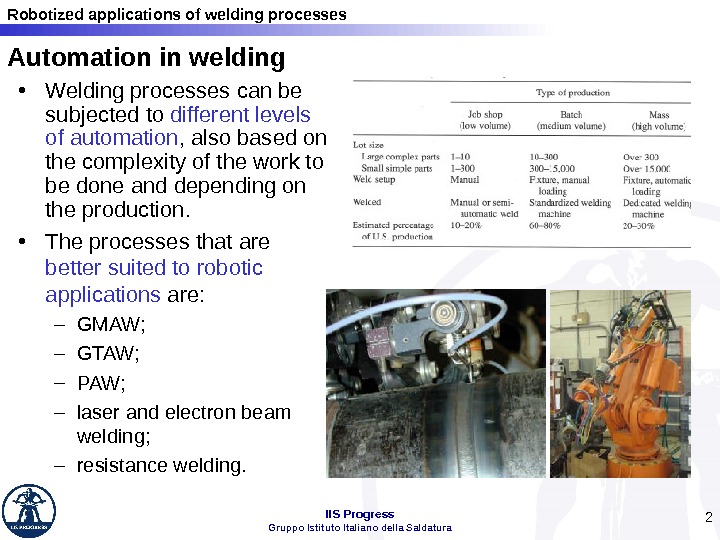
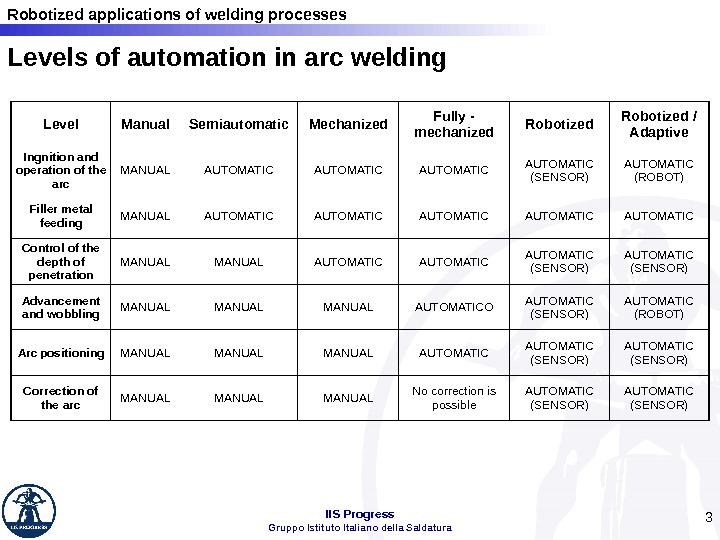
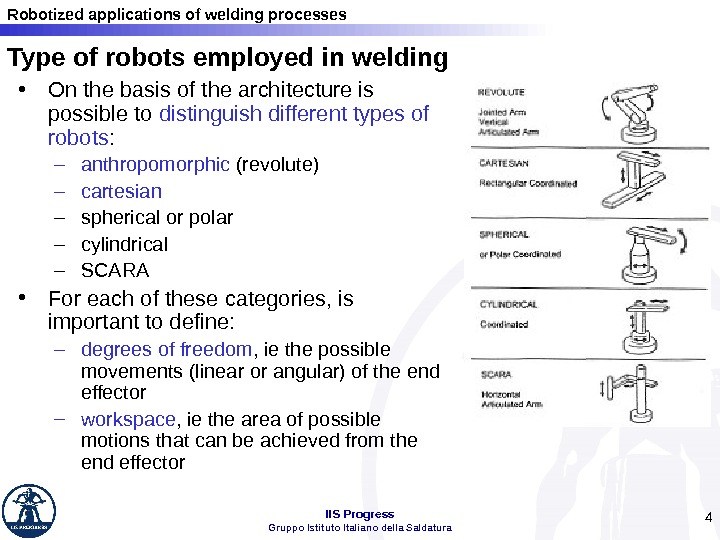

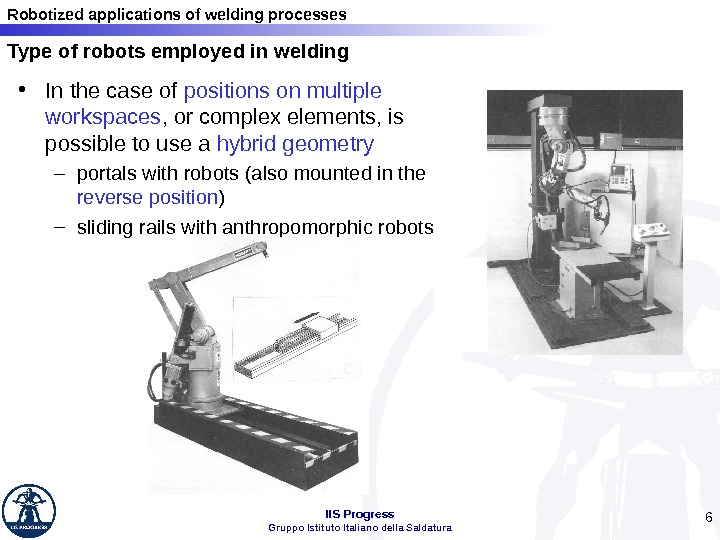
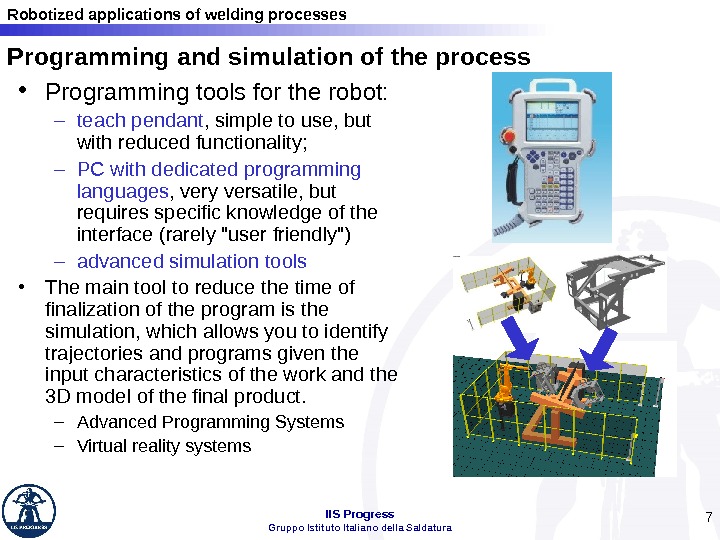
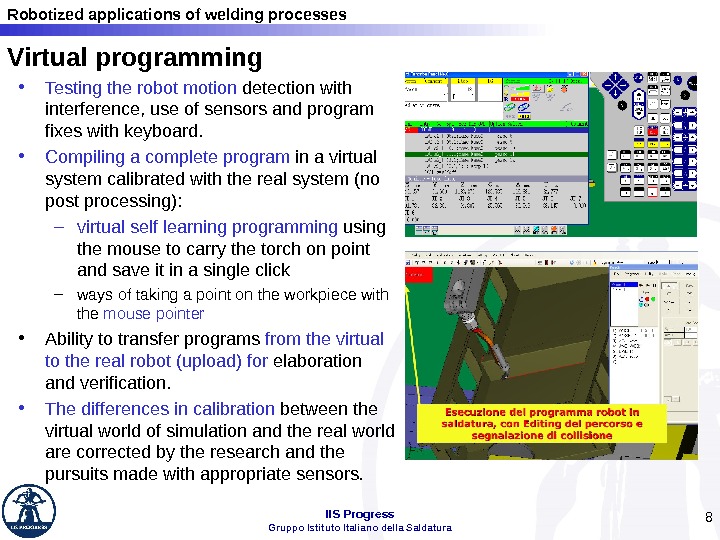
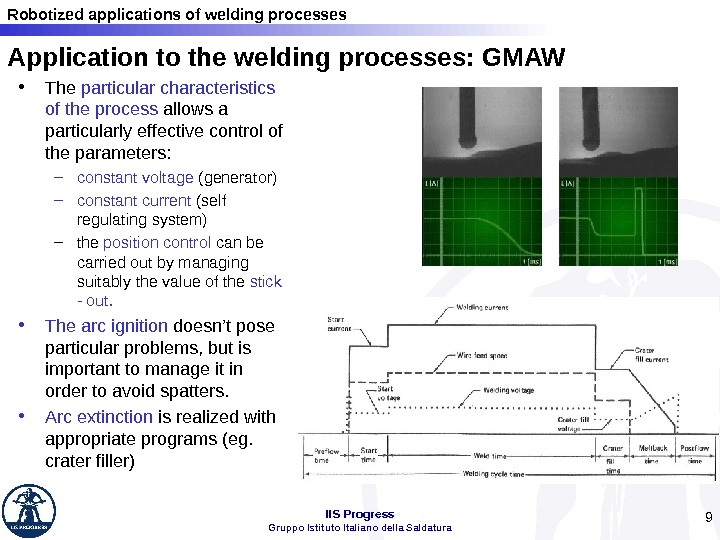
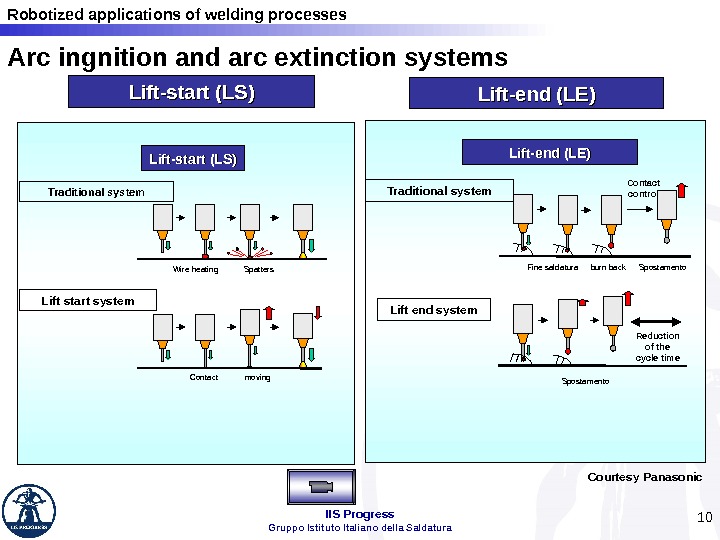
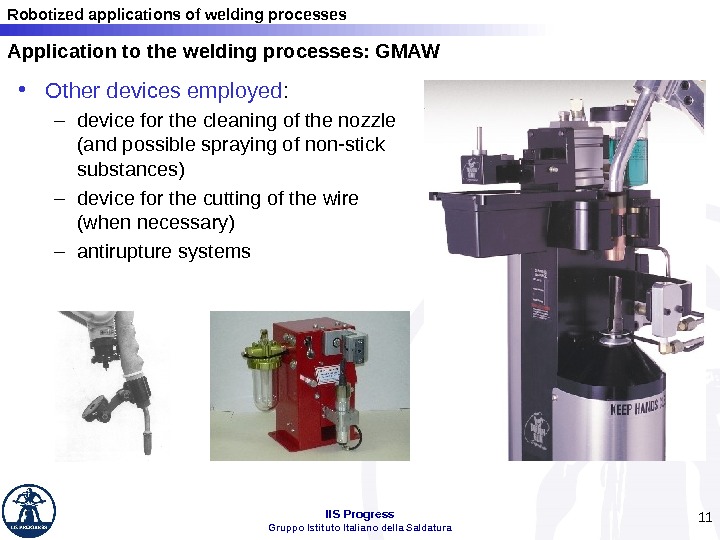
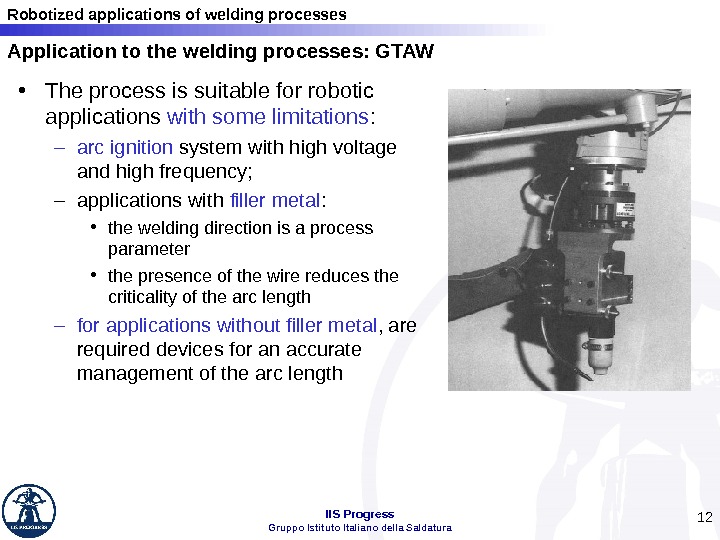
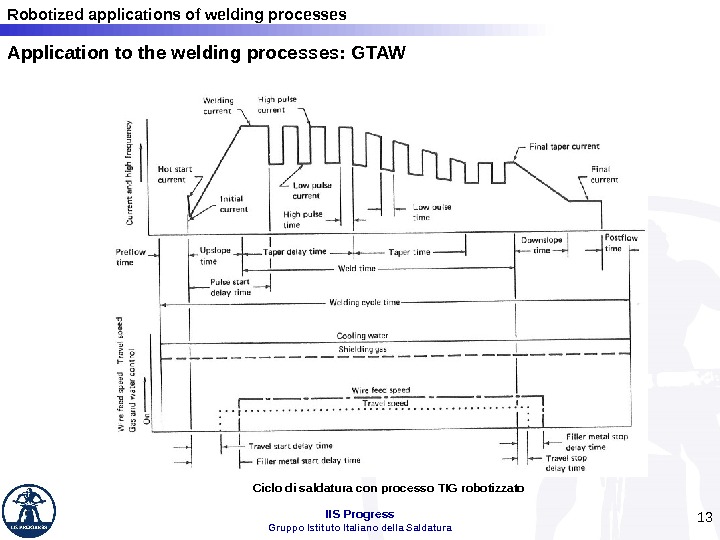



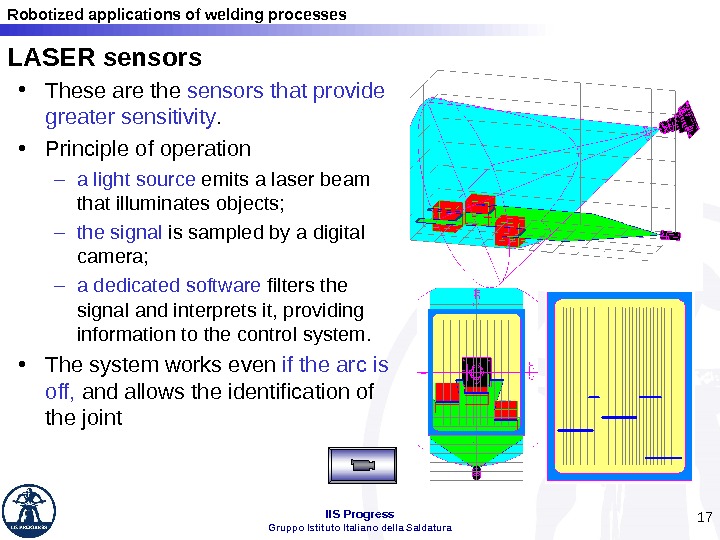
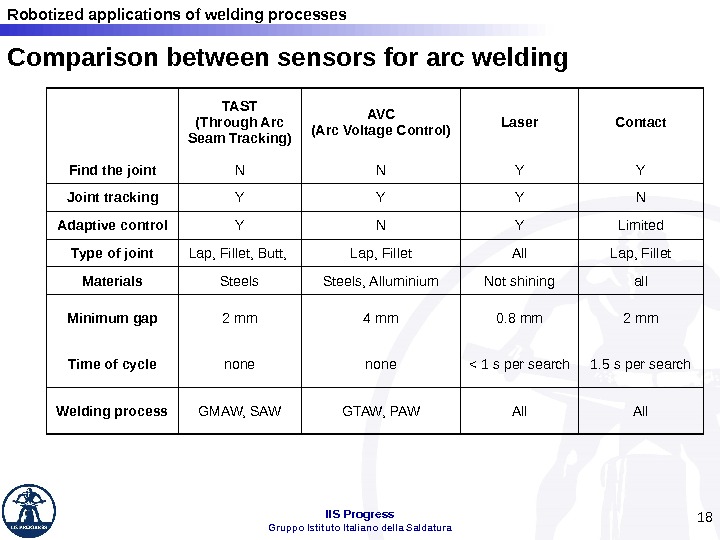
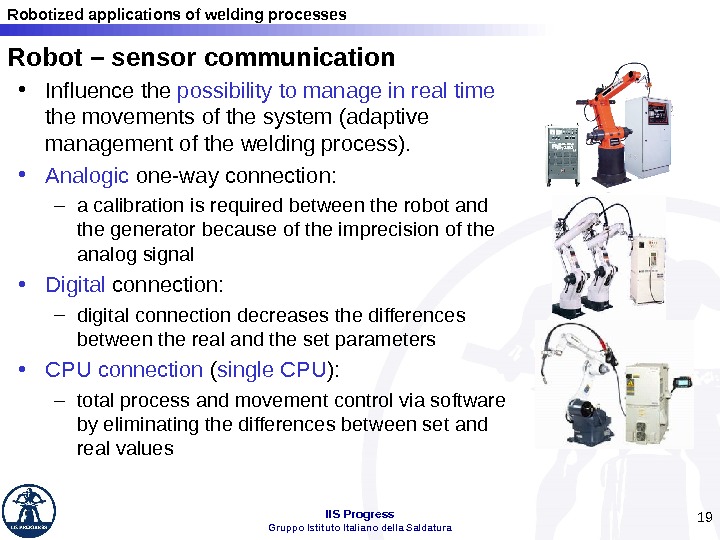
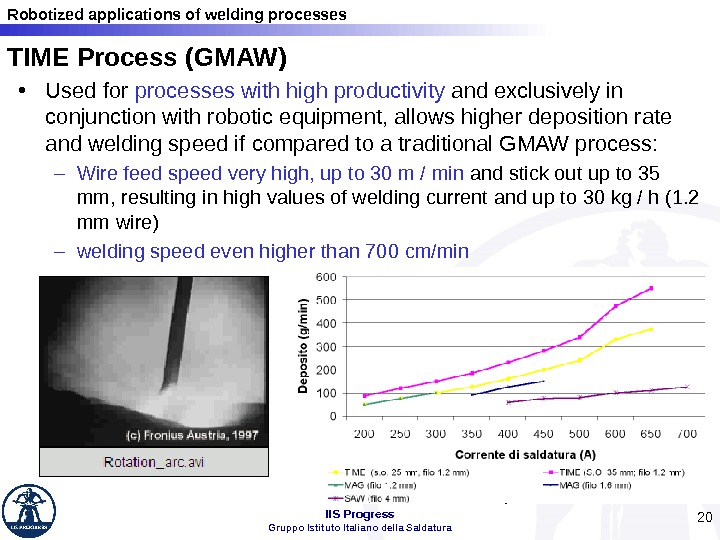
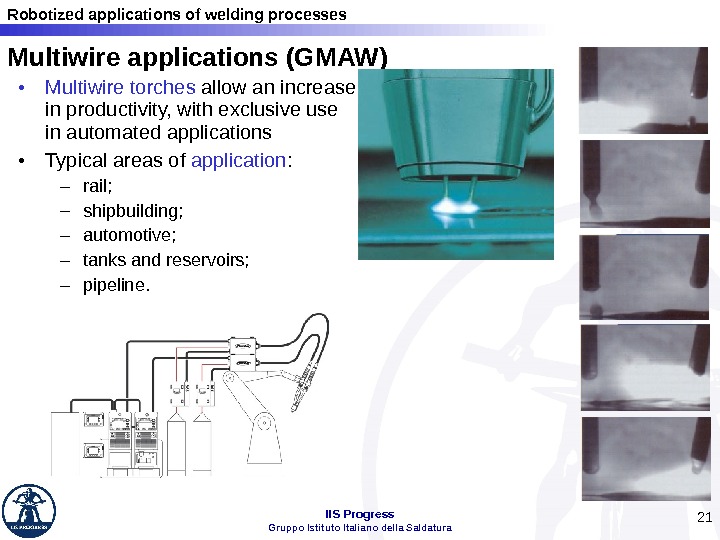
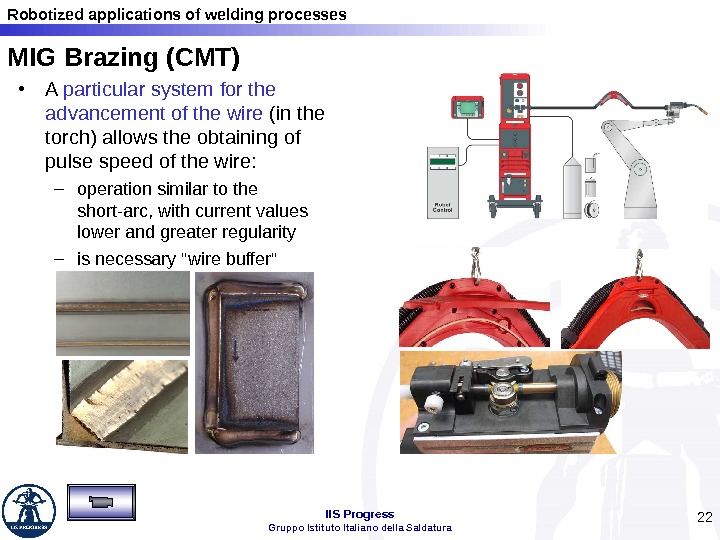
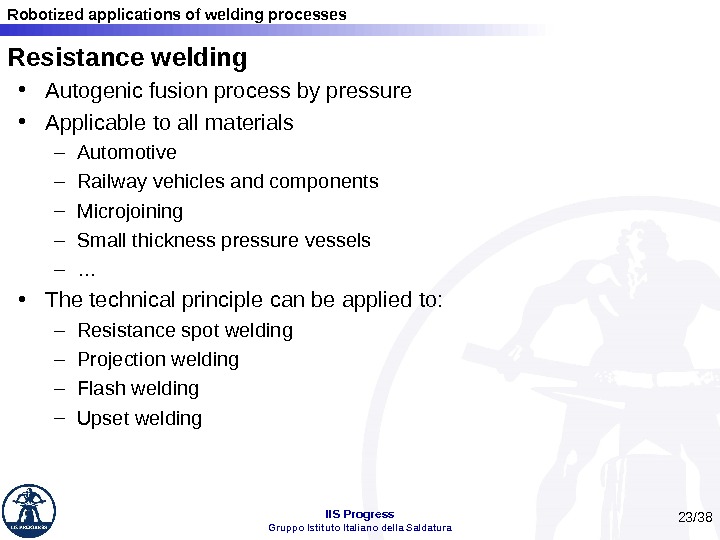
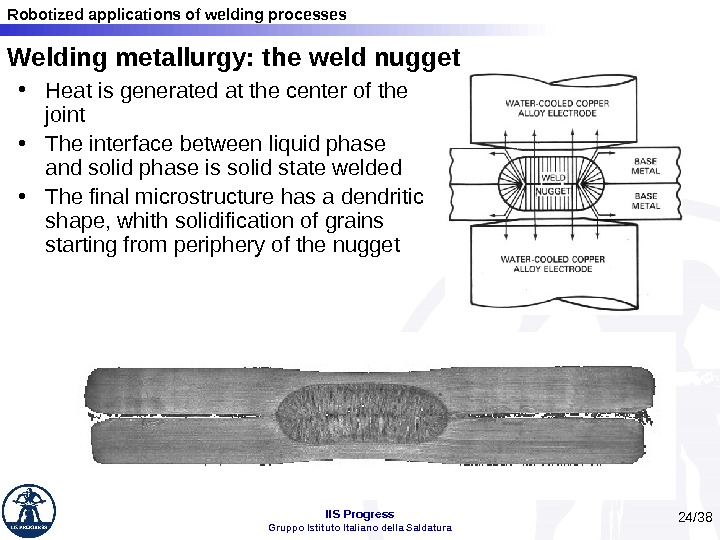
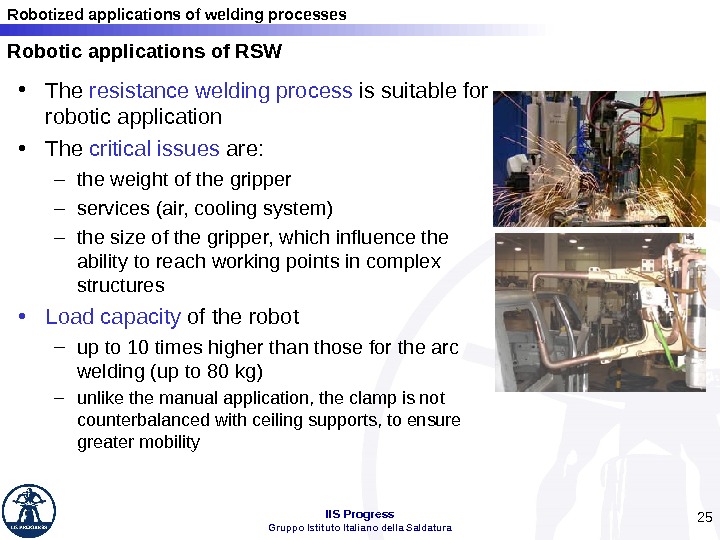
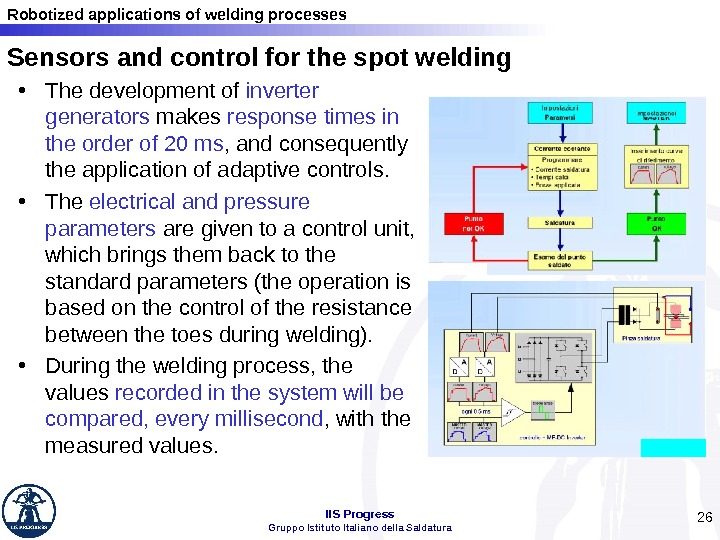
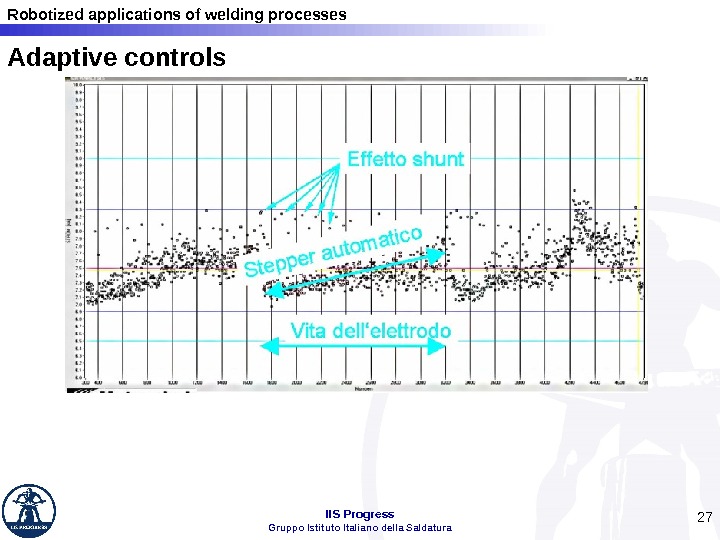
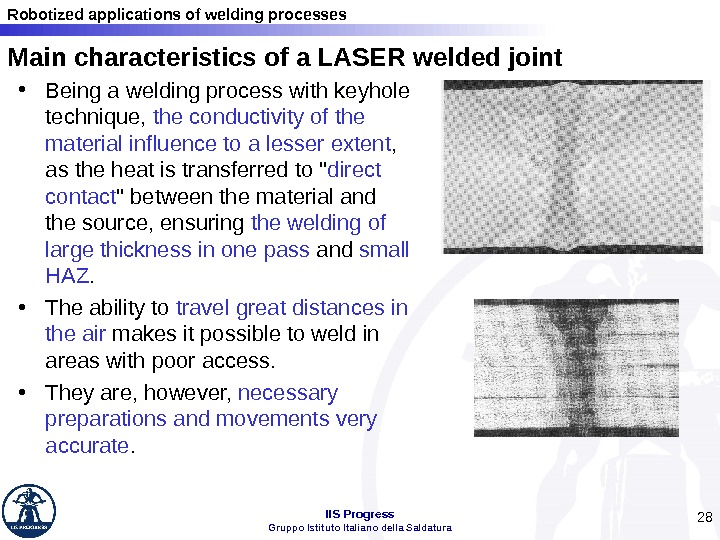
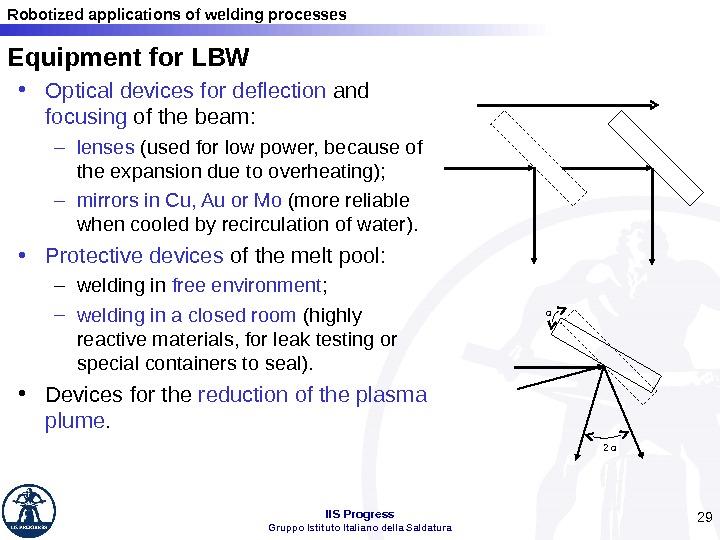
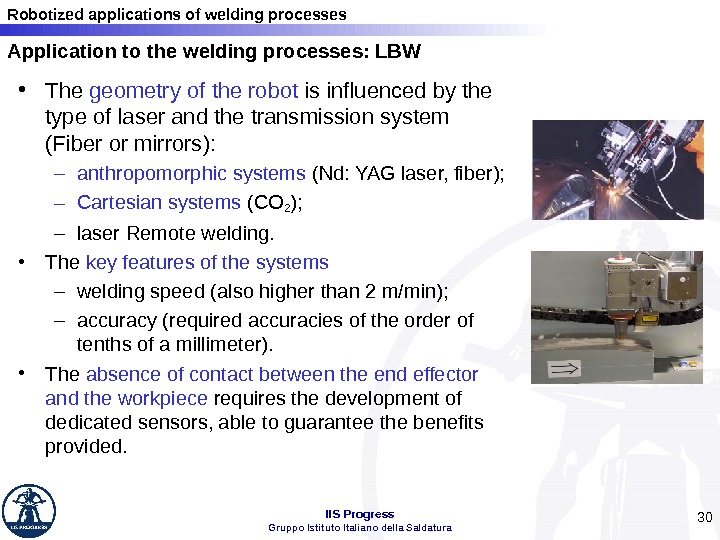
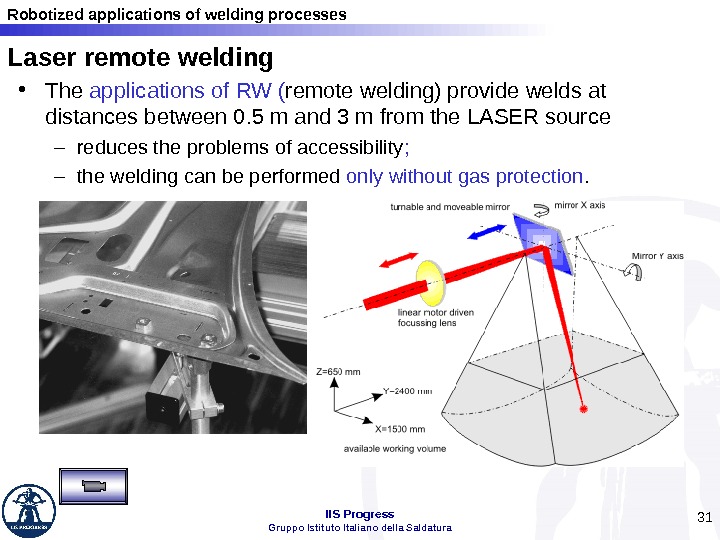
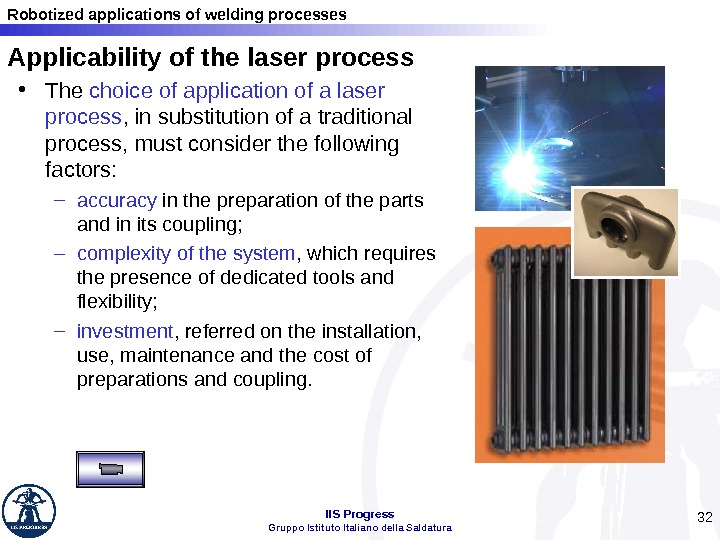
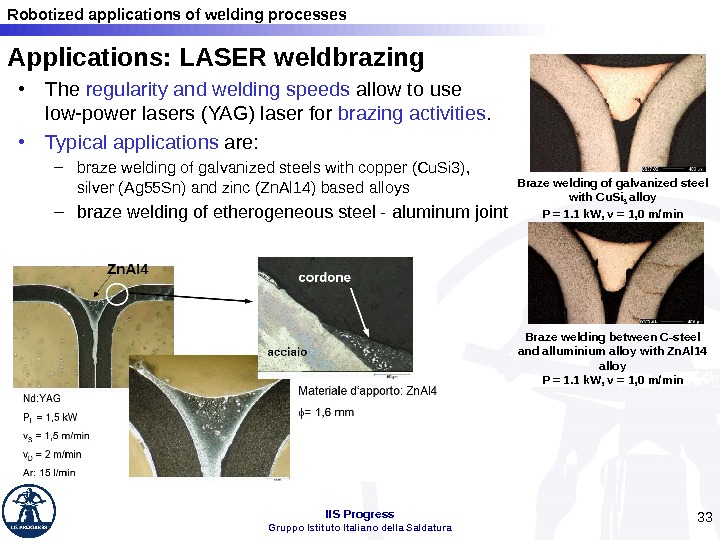
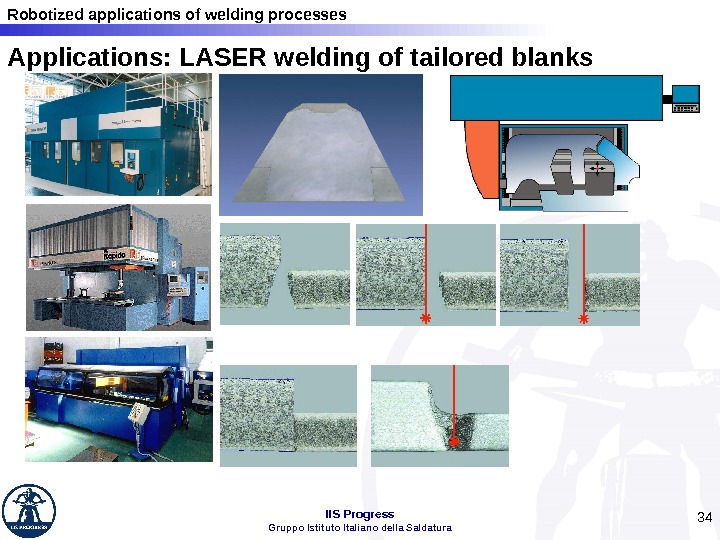
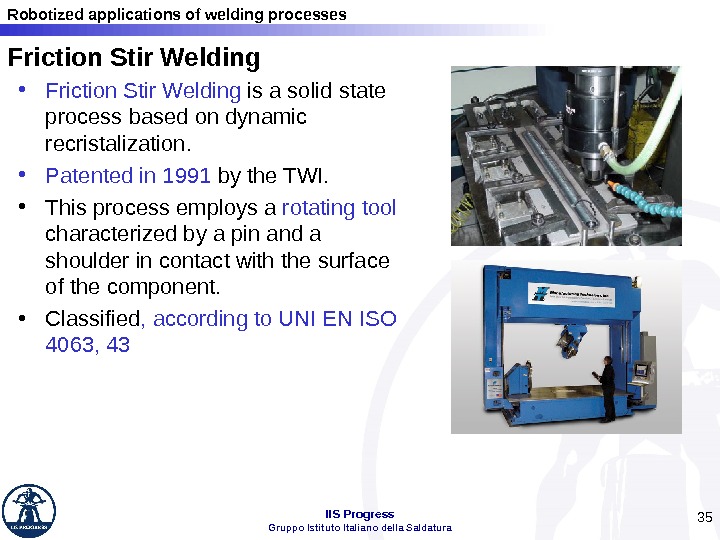
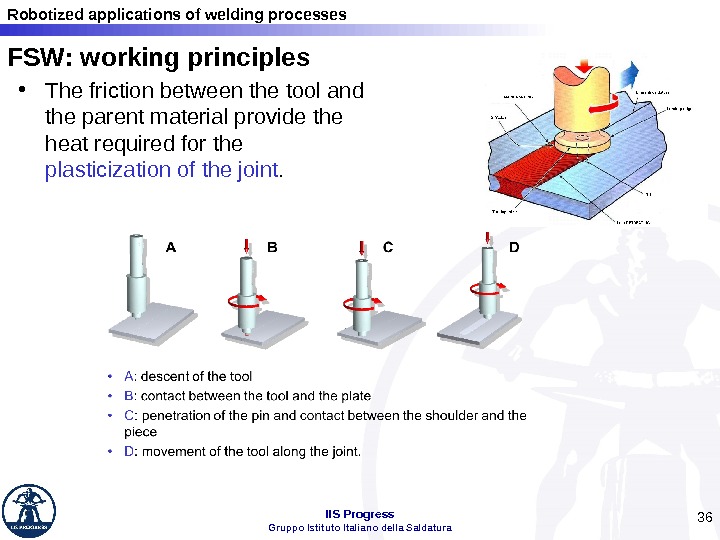

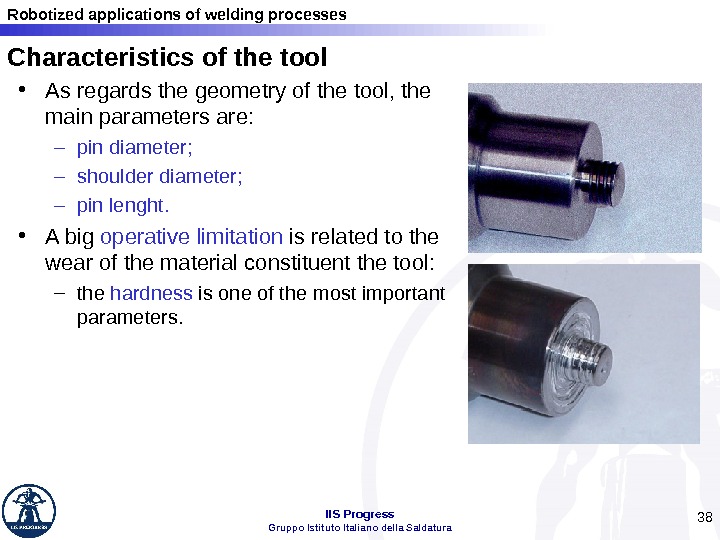
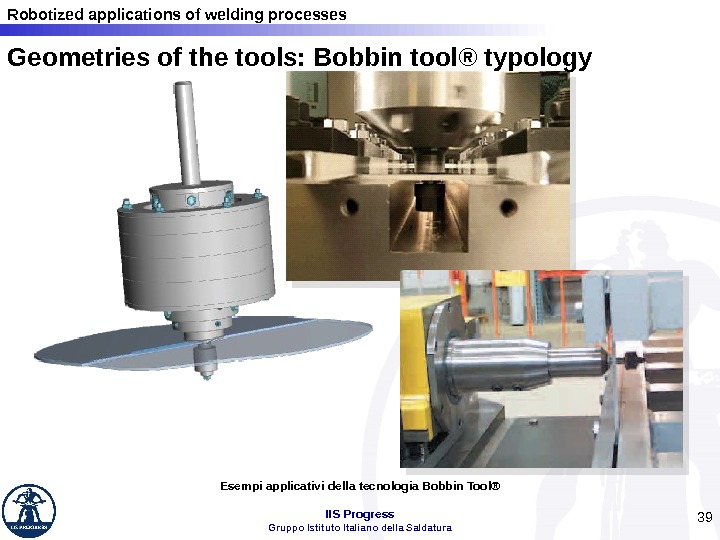
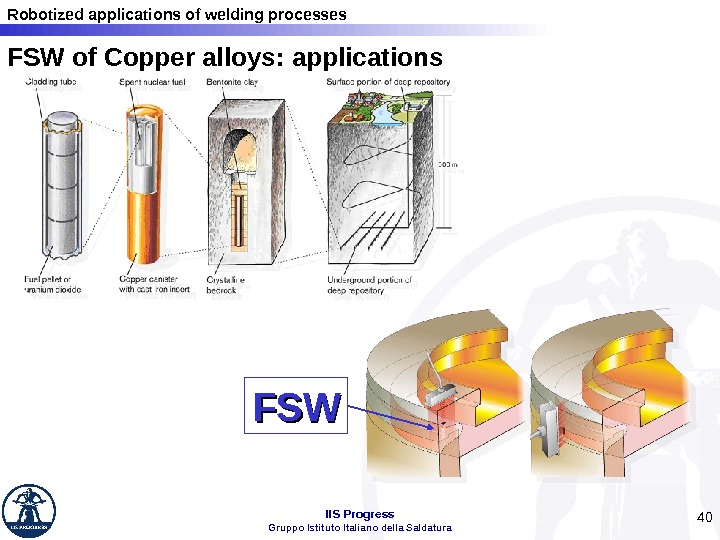
03_-_automatic_and_robotized_welding.ppt
- Размер: 11.8 Mегабайта
- Количество слайдов: 40
Описание презентации Welding Technology Automatic and robotized applications of welding по слайдам
 Welding Technology Automatic and robotized applications of welding processes Data ultimo aggiornamento: 30/05/
Welding Technology Automatic and robotized applications of welding processes Data ultimo aggiornamento: 30/05/
 Robotized applications of welding processes IIS Progress Gruppo Istituto Italiano della Saldatura 2 Automation in welding • Welding processes can be subjected to different levels of automation , also based on the complexity of the work to be done and depending on the production. • The processes that are better suited to robotic applications are: – GMAW; – GTAW; – PAW; – laser and electron beam welding; – resistance welding.
Robotized applications of welding processes IIS Progress Gruppo Istituto Italiano della Saldatura 2 Automation in welding • Welding processes can be subjected to different levels of automation , also based on the complexity of the work to be done and depending on the production. • The processes that are better suited to robotic applications are: – GMAW; – GTAW; – PAW; – laser and electron beam welding; – resistance welding.
 Robotized applications of welding processes IIS Progress Gruppo Istituto Italiano della Saldatura 3 Level Manual Semiautomatic Mechanized Fully — mechanized Robotized / Adaptive Ingnition and operation of the arc MANUAL AUTOMATIC (SENSOR) AUTOMATIC (ROBOT) Filler metal feeding MANUAL AUTOMATIC AUTOMATIC Control of the depth of penetration MANUAL AUTOMATIC (SENSOR) Advancement and wobbling MANUAL AUTOMATICO AUTOMATIC (SENSOR) AUTOMATIC (ROBOT) Arc positioning MANUAL AUTOMATIC (SENSOR) Correction of the arc MANUAL No correction is possible AUTOMATIC (SENSOR)Levels of automation in arc welding
Robotized applications of welding processes IIS Progress Gruppo Istituto Italiano della Saldatura 3 Level Manual Semiautomatic Mechanized Fully — mechanized Robotized / Adaptive Ingnition and operation of the arc MANUAL AUTOMATIC (SENSOR) AUTOMATIC (ROBOT) Filler metal feeding MANUAL AUTOMATIC AUTOMATIC Control of the depth of penetration MANUAL AUTOMATIC (SENSOR) Advancement and wobbling MANUAL AUTOMATICO AUTOMATIC (SENSOR) AUTOMATIC (ROBOT) Arc positioning MANUAL AUTOMATIC (SENSOR) Correction of the arc MANUAL No correction is possible AUTOMATIC (SENSOR)Levels of automation in arc welding
 Robotized applications of welding processes IIS Progress Gruppo Istituto Italiano della Saldatura 4 Type of robots employed in welding • On the basis of the architecture is possible to distinguish different types of robots : – anthropomorphic (revolute) – cartesian – spherical or polar – cylindrical – SCARA • For each of these categories, is important to define: – degrees of freedom , ie the possible movements (linear or angular) of the end effector – workspace , ie the area of possible motions that can be achieved from the end effector
Robotized applications of welding processes IIS Progress Gruppo Istituto Italiano della Saldatura 4 Type of robots employed in welding • On the basis of the architecture is possible to distinguish different types of robots : – anthropomorphic (revolute) – cartesian – spherical or polar – cylindrical – SCARA • For each of these categories, is important to define: – degrees of freedom , ie the possible movements (linear or angular) of the end effector – workspace , ie the area of possible motions that can be achieved from the end effector
 Robotized applications of welding processes IIS Progress Gruppo Istituto Italiano della Saldatura 5 • An interesting opportunity is the ability to use hollow wrist robots : – easier movement; – wider workspace; – easier PC simulation. Anthropomorphic robot configuration
Robotized applications of welding processes IIS Progress Gruppo Istituto Italiano della Saldatura 5 • An interesting opportunity is the ability to use hollow wrist robots : – easier movement; – wider workspace; – easier PC simulation. Anthropomorphic robot configuration
 Robotized applications of welding processes IIS Progress Gruppo Istituto Italiano della Saldatura 6 • In the case of positions on multiple workspaces , or complex elements, is possible to use a hybrid geometry – portals with robots (also mounted in the reverse position ) – sliding rails with anthropomorphic robots. Type of robots employed in welding
Robotized applications of welding processes IIS Progress Gruppo Istituto Italiano della Saldatura 6 • In the case of positions on multiple workspaces , or complex elements, is possible to use a hybrid geometry – portals with robots (also mounted in the reverse position ) – sliding rails with anthropomorphic robots. Type of robots employed in welding
 Robotized applications of welding processes IIS Progress Gruppo Istituto Italiano della Saldatura 7 Programming and simulation of the process • Programming tools for the robot: – teach pendant , simple to use, but with reduced functionality; – PC with dedicated programming languages , very versatile, but requires specific knowledge of the interface (rarely «user friendly») – advanced simulation tools • The main tool to reduce the time of finalization of the program is the simulation, which allows you to identify trajectories and programs given the input characteristics of the work and the 3 D model of the final product. – Advanced Programming Systems – Virtual reality systems
Robotized applications of welding processes IIS Progress Gruppo Istituto Italiano della Saldatura 7 Programming and simulation of the process • Programming tools for the robot: – teach pendant , simple to use, but with reduced functionality; – PC with dedicated programming languages , very versatile, but requires specific knowledge of the interface (rarely «user friendly») – advanced simulation tools • The main tool to reduce the time of finalization of the program is the simulation, which allows you to identify trajectories and programs given the input characteristics of the work and the 3 D model of the final product. – Advanced Programming Systems – Virtual reality systems
 Robotized applications of welding processes IIS Progress Gruppo Istituto Italiano della Saldatura 8 Virtual programming • Testing the robot motion detection with interference, use of sensors and program fixes with keyboard. • Compiling a complete program in a virtual system calibrated with the real system (no post processing): – virtual self learning programming using the mouse to carry the torch on point and save it in a single click – ways of taking a point on the workpiece with the mouse pointer • Ability to transfer programs from the virtual to the real robot (upload) for elaboration and verification. • The differences in calibration between the virtual world of simulation and the real world are corrected by the research and the pursuits made with appropriate sensors.
Robotized applications of welding processes IIS Progress Gruppo Istituto Italiano della Saldatura 8 Virtual programming • Testing the robot motion detection with interference, use of sensors and program fixes with keyboard. • Compiling a complete program in a virtual system calibrated with the real system (no post processing): – virtual self learning programming using the mouse to carry the torch on point and save it in a single click – ways of taking a point on the workpiece with the mouse pointer • Ability to transfer programs from the virtual to the real robot (upload) for elaboration and verification. • The differences in calibration between the virtual world of simulation and the real world are corrected by the research and the pursuits made with appropriate sensors.
 Robotized applications of welding processes IIS Progress Gruppo Istituto Italiano della Saldatura 9 Application to the welding processes: GMAW • The particular characteristics of the process allows a particularly effective control of the parameters: – constant voltage (generator) – constant current (self regulating system) – the position control can be carried out by managing suitably the value of the stick — out. • The arc ignition doesn’t pose particular problems, but is important to manage it in order to avoid spatters. • Arc extinction is realized with appropriate programs (eg. crater filler)
Robotized applications of welding processes IIS Progress Gruppo Istituto Italiano della Saldatura 9 Application to the welding processes: GMAW • The particular characteristics of the process allows a particularly effective control of the parameters: – constant voltage (generator) – constant current (self regulating system) – the position control can be carried out by managing suitably the value of the stick — out. • The arc ignition doesn’t pose particular problems, but is important to manage it in order to avoid spatters. • Arc extinction is realized with appropriate programs (eg. crater filler)
 Robotized applications of welding processes IIS Progress Gruppo Istituto Italiano della Saldatura 10 Traditional system Lift start system Lift-start (LS) Lift-end (LE) Traditional system Lift end system. Lift-start (LS) Lift-end (LE) Contact Spatters Wire heating moving Spostamentoburn back. Fine saldatura Contact control Reduction of the cycle time Spostamento Arc ingnition and arc extinction systems Courtesy Panasonic
Robotized applications of welding processes IIS Progress Gruppo Istituto Italiano della Saldatura 10 Traditional system Lift start system Lift-start (LS) Lift-end (LE) Traditional system Lift end system. Lift-start (LS) Lift-end (LE) Contact Spatters Wire heating moving Spostamentoburn back. Fine saldatura Contact control Reduction of the cycle time Spostamento Arc ingnition and arc extinction systems Courtesy Panasonic
 Robotized applications of welding processes IIS Progress Gruppo Istituto Italiano della Saldatura 11 • Other devices employed : – device for the cleaning of the nozzle (and possible spraying of non-stick substances) – device for the cutting of the wire (when necessary) – antirupture systems. Application to the welding processes: GMAW
Robotized applications of welding processes IIS Progress Gruppo Istituto Italiano della Saldatura 11 • Other devices employed : – device for the cleaning of the nozzle (and possible spraying of non-stick substances) – device for the cutting of the wire (when necessary) – antirupture systems. Application to the welding processes: GMAW
 Robotized applications of welding processes IIS Progress Gruppo Istituto Italiano della Saldatura 12 • The process is suitable for robotic applications with some limitations : – arc ignition system with high voltage and high frequency; – applications with filler metal : • the welding direction is a process parameter • the presence of the wire reduces the criticality of the arc length – for applications without filler metal , are required devices for an accurate management of the arc length. Application to the welding processes: GTAW
Robotized applications of welding processes IIS Progress Gruppo Istituto Italiano della Saldatura 12 • The process is suitable for robotic applications with some limitations : – arc ignition system with high voltage and high frequency; – applications with filler metal : • the welding direction is a process parameter • the presence of the wire reduces the criticality of the arc length – for applications without filler metal , are required devices for an accurate management of the arc length. Application to the welding processes: GTAW
 Robotized applications of welding processes IIS Progress Gruppo Istituto Italiano della Saldatura 13 Ciclo di saldatura con processo TIG robotizzato. Application to the welding processes: GTAW
Robotized applications of welding processes IIS Progress Gruppo Istituto Italiano della Saldatura 13 Ciclo di saldatura con processo TIG robotizzato. Application to the welding processes: GTAW
 Robotized applications of welding processes IIS Progress Gruppo Istituto Italiano della Saldatura 14 Contact sensors for arc welding • They are primarily used for the tracking of the joint. • Can be simple probes or complex electromechanical systems , generally oscillating along the bevel. • The distance between the sensor and the arc can be a source of problems for complex paths (high distance) or for overheating (low distance).
Robotized applications of welding processes IIS Progress Gruppo Istituto Italiano della Saldatura 14 Contact sensors for arc welding • They are primarily used for the tracking of the joint. • Can be simple probes or complex electromechanical systems , generally oscillating along the bevel. • The distance between the sensor and the arc can be a source of problems for complex paths (high distance) or for overheating (low distance).
 Robotized applications of welding processes IIS Progress Gruppo Istituto Italiano della Saldatura 15 Arc based sensors • The simplest system is based on the arc voltage (eg, submerged arc). • The most common case is that of tracking systems of the joint, based on torch movements and consequent variation of the values of voltage and / or current (the movement of oscillation is adjusted in order to obtain the constant fluctuation of these parameters). TAST system
Robotized applications of welding processes IIS Progress Gruppo Istituto Italiano della Saldatura 15 Arc based sensors • The simplest system is based on the arc voltage (eg, submerged arc). • The most common case is that of tracking systems of the joint, based on torch movements and consequent variation of the values of voltage and / or current (the movement of oscillation is adjusted in order to obtain the constant fluctuation of these parameters). TAST system
 Robotized applications of welding processes IIS Progress Gruppo Istituto Italiano della Saldatura 16 Vision base sensors • These systems can capture an image and process it to handle : – tracking of the joint – penetration – size of the melt pool – shape of the deposit (for example for welding in position) • To make the system less sensitive to light emission of the arc , are used sensors for specific wavelengths coupled with a high power laser beam. • The complexity is related to information management systems and to the logic for the correction of the welding parameters
Robotized applications of welding processes IIS Progress Gruppo Istituto Italiano della Saldatura 16 Vision base sensors • These systems can capture an image and process it to handle : – tracking of the joint – penetration – size of the melt pool – shape of the deposit (for example for welding in position) • To make the system less sensitive to light emission of the arc , are used sensors for specific wavelengths coupled with a high power laser beam. • The complexity is related to information management systems and to the logic for the correction of the welding parameters
 Robotized applications of welding processes IIS Progress Gruppo Istituto Italiano della Saldatura 17 LASER sensors • These are the sensors that provide greater sensitivity. • Principle of operation – a light source emits a laser beam that illuminates objects; – the signal is sampled by a digital camera; – a dedicated software filters the signal and interprets it, providing information to the control system. • The system works even if the arc is off, and allows the identification of the joint
Robotized applications of welding processes IIS Progress Gruppo Istituto Italiano della Saldatura 17 LASER sensors • These are the sensors that provide greater sensitivity. • Principle of operation – a light source emits a laser beam that illuminates objects; – the signal is sampled by a digital camera; – a dedicated software filters the signal and interprets it, providing information to the control system. • The system works even if the arc is off, and allows the identification of the joint
 Robotized applications of welding processes IIS Progress Gruppo Istituto Italiano della Saldatura 18 Comparison between sensors for arc welding TAST ( Through Arc Seam Tracking) AVC (Arc Voltage Control) Laser Contact Find the joint N N Y Y Joint tracking Y Y Y N Adaptive control Y N Y Limited Type of joint Lap, Fillet, Butt, Lap, Fillet All Lap, Fillet Materials Steels, Alluminium Not shining all Minimum gap 2 mm 4 mm 0. 8 mm 2 mm Time of cycle none < 1 s per search 1. 5 s per search Welding process GMAW, SAW GTAW, PAW All
Robotized applications of welding processes IIS Progress Gruppo Istituto Italiano della Saldatura 18 Comparison between sensors for arc welding TAST ( Through Arc Seam Tracking) AVC (Arc Voltage Control) Laser Contact Find the joint N N Y Y Joint tracking Y Y Y N Adaptive control Y N Y Limited Type of joint Lap, Fillet, Butt, Lap, Fillet All Lap, Fillet Materials Steels, Alluminium Not shining all Minimum gap 2 mm 4 mm 0. 8 mm 2 mm Time of cycle none < 1 s per search 1. 5 s per search Welding process GMAW, SAW GTAW, PAW All
 Robotized applications of welding processes IIS Progress Gruppo Istituto Italiano della Saldatura 19 Robot – sensor communication • Influence the possibility to manage in real time the movements of the system (adaptive management of the welding process). • Analogic one-way connection: – a calibration is required between the robot and the generator because of the imprecision of the analog signal • Digital connection: – digital connection decreases the differences between the real and the set parameters • CPU connection ( single CPU ): – total process and movement control via software by eliminating the differences between set and real values
Robotized applications of welding processes IIS Progress Gruppo Istituto Italiano della Saldatura 19 Robot – sensor communication • Influence the possibility to manage in real time the movements of the system (adaptive management of the welding process). • Analogic one-way connection: – a calibration is required between the robot and the generator because of the imprecision of the analog signal • Digital connection: – digital connection decreases the differences between the real and the set parameters • CPU connection ( single CPU ): – total process and movement control via software by eliminating the differences between set and real values
 Robotized applications of welding processes IIS Progress Gruppo Istituto Italiano della Saldatura 20 TIME Process (GMAW) • Used for processes with high productivity and exclusively in conjunction with robotic equipment, allows higher deposition rate and welding speed if compared to a traditional GMAW process: – Wire feed speed very high, up to 30 m / min and stick out up to 35 mm, resulting in high values of welding current and up to 30 kg / h (1. 2 mm wire) – welding speed even higher than 700 cm/min
Robotized applications of welding processes IIS Progress Gruppo Istituto Italiano della Saldatura 20 TIME Process (GMAW) • Used for processes with high productivity and exclusively in conjunction with robotic equipment, allows higher deposition rate and welding speed if compared to a traditional GMAW process: – Wire feed speed very high, up to 30 m / min and stick out up to 35 mm, resulting in high values of welding current and up to 30 kg / h (1. 2 mm wire) – welding speed even higher than 700 cm/min
 Robotized applications of welding processes IIS Progress Gruppo Istituto Italiano della Saldatura 21 Multiwire applications (GMAW) • Multiwire torches allow an increase in productivity, with exclusive use in automated applications • Typical areas of application : – rail; – shipbuilding; – automotive; – tanks and reservoirs; – pipeline.
Robotized applications of welding processes IIS Progress Gruppo Istituto Italiano della Saldatura 21 Multiwire applications (GMAW) • Multiwire torches allow an increase in productivity, with exclusive use in automated applications • Typical areas of application : – rail; – shipbuilding; – automotive; – tanks and reservoirs; – pipeline.
 Robotized applications of welding processes IIS Progress Gruppo Istituto Italiano della Saldatura 22 MIG Brazing (CMT) • A particular system for the advancement of the wire (in the torch) allows the obtaining of pulse speed of the wire: – operation similar to the short-arc, with current values lower and greater regularity – is necessary «wire buffer»
Robotized applications of welding processes IIS Progress Gruppo Istituto Italiano della Saldatura 22 MIG Brazing (CMT) • A particular system for the advancement of the wire (in the torch) allows the obtaining of pulse speed of the wire: – operation similar to the short-arc, with current values lower and greater regularity – is necessary «wire buffer»
 Robotized applications of welding processes IIS Progress Gruppo Istituto Italiano della Saldatura 23 /38 Resistance welding • Autogenic fusion process by pressure • Applicable to all materials – Automotive – Railway vehicles and components – Microjoining – Small thickness pressure vessels – … • The technical principle can be applied to: – Resistance spot welding – Projection welding – Flash welding – Upset welding
Robotized applications of welding processes IIS Progress Gruppo Istituto Italiano della Saldatura 23 /38 Resistance welding • Autogenic fusion process by pressure • Applicable to all materials – Automotive – Railway vehicles and components – Microjoining – Small thickness pressure vessels – … • The technical principle can be applied to: – Resistance spot welding – Projection welding – Flash welding – Upset welding
 Robotized applications of welding processes IIS Progress Gruppo Istituto Italiano della Saldatura 24 /38 Welding metallurgy: the weld nugget • Heat is generated at the center of the joint • The interface between liquid phase and solid phase is solid state welded • The final microstructure has a dendritic shape, whith solidification of grains starting from periphery of the nugget
Robotized applications of welding processes IIS Progress Gruppo Istituto Italiano della Saldatura 24 /38 Welding metallurgy: the weld nugget • Heat is generated at the center of the joint • The interface between liquid phase and solid phase is solid state welded • The final microstructure has a dendritic shape, whith solidification of grains starting from periphery of the nugget
 Robotized applications of welding processes IIS Progress Gruppo Istituto Italiano della Saldatura 25 • The resistance welding process is suitable for robotic application • The critical issues are: – the weight of the gripper – services (air, cooling system) – the size of the gripper, which influence the ability to reach working points in complex structures • Load capacity of the robot – up to 10 times higher than those for the arc welding (up to 80 kg) – unlike the manual application, the clamp is not counterbalanced with ceiling supports, to ensure greater mobility. Robotic applications of RSW
Robotized applications of welding processes IIS Progress Gruppo Istituto Italiano della Saldatura 25 • The resistance welding process is suitable for robotic application • The critical issues are: – the weight of the gripper – services (air, cooling system) – the size of the gripper, which influence the ability to reach working points in complex structures • Load capacity of the robot – up to 10 times higher than those for the arc welding (up to 80 kg) – unlike the manual application, the clamp is not counterbalanced with ceiling supports, to ensure greater mobility. Robotic applications of RSW
 Robotized applications of welding processes IIS Progress Gruppo Istituto Italiano della Saldatura 26 Sensors and control for the spot welding • The development of inverter generators makes response times in the order of 20 ms , and consequently the application of adaptive controls. • The electrical and pressure parameters are given to a control unit, which brings them back to the standard parameters (the operation is based on the control of the resistance between the toes during welding). • During the welding process, the values recorded in the system will be compared, every millisecond , with the measured values .
Robotized applications of welding processes IIS Progress Gruppo Istituto Italiano della Saldatura 26 Sensors and control for the spot welding • The development of inverter generators makes response times in the order of 20 ms , and consequently the application of adaptive controls. • The electrical and pressure parameters are given to a control unit, which brings them back to the standard parameters (the operation is based on the control of the resistance between the toes during welding). • During the welding process, the values recorded in the system will be compared, every millisecond , with the measured values .
 Robotized applications of welding processes IIS Progress Gruppo Istituto Italiano della Saldatura 27 Adaptive controls
Robotized applications of welding processes IIS Progress Gruppo Istituto Italiano della Saldatura 27 Adaptive controls
 Robotized applications of welding processes IIS Progress Gruppo Istituto Italiano della Saldatura 28 • Being a welding process with keyhole technique, the conductivity of the material influence to a lesser extent , as the heat is transferred to » direct contact » between the material and the source, ensuring the welding of large thickness in one pass and small HAZ. • The ability to travel great distances in the air makes it possible to weld in areas with poor access. • They are, however, necessary preparations and movements very accurate. Main characteristics of a LASER welded joint
Robotized applications of welding processes IIS Progress Gruppo Istituto Italiano della Saldatura 28 • Being a welding process with keyhole technique, the conductivity of the material influence to a lesser extent , as the heat is transferred to » direct contact » between the material and the source, ensuring the welding of large thickness in one pass and small HAZ. • The ability to travel great distances in the air makes it possible to weld in areas with poor access. • They are, however, necessary preparations and movements very accurate. Main characteristics of a LASER welded joint
 Robotized applications of welding processes IIS Progress Gruppo Istituto Italiano della Saldatura 29 • Optical devices for deflection and focusing of the beam: – lenses (used for low power, because of the expansion due to overheating); – mirrors in Cu, Au or Mo (more reliable when cooled by recirculation of water). • Protective devices of the melt pool: – welding in free environment ; – welding in a closed room (highly reactive materials, for leak testing or special containers to seal). • Devices for the reduction of the plasma plume. α 2 αEquipment for LBW
Robotized applications of welding processes IIS Progress Gruppo Istituto Italiano della Saldatura 29 • Optical devices for deflection and focusing of the beam: – lenses (used for low power, because of the expansion due to overheating); – mirrors in Cu, Au or Mo (more reliable when cooled by recirculation of water). • Protective devices of the melt pool: – welding in free environment ; – welding in a closed room (highly reactive materials, for leak testing or special containers to seal). • Devices for the reduction of the plasma plume. α 2 αEquipment for LBW
 Robotized applications of welding processes IIS Progress Gruppo Istituto Italiano della Saldatura 30 • The geometry of the robot is influenced by the type of laser and the transmission system (Fiber or mirrors): – anthropomorphic systems (Nd: YAG laser, fiber); – Cartesian systems (CO 2 ); – laser Remote welding. • The key features of the systems – welding speed (also higher than 2 m/min); – accuracy (required accuracies of the order of tenths of a millimeter). • The absence of contact between the end effector and the workpiece requires the development of dedicated sensors, able to guarantee the benefits provided. Application to the welding processes: LBW
Robotized applications of welding processes IIS Progress Gruppo Istituto Italiano della Saldatura 30 • The geometry of the robot is influenced by the type of laser and the transmission system (Fiber or mirrors): – anthropomorphic systems (Nd: YAG laser, fiber); – Cartesian systems (CO 2 ); – laser Remote welding. • The key features of the systems – welding speed (also higher than 2 m/min); – accuracy (required accuracies of the order of tenths of a millimeter). • The absence of contact between the end effector and the workpiece requires the development of dedicated sensors, able to guarantee the benefits provided. Application to the welding processes: LBW
 Robotized applications of welding processes IIS Progress Gruppo Istituto Italiano della Saldatura 31 Laser remote welding • The applications of RW ( remote welding) provide welds at distances between 0. 5 m and 3 m from the LASER source – reduces the problems of accessibility ; – the welding can be performed only without gas protection.
Robotized applications of welding processes IIS Progress Gruppo Istituto Italiano della Saldatura 31 Laser remote welding • The applications of RW ( remote welding) provide welds at distances between 0. 5 m and 3 m from the LASER source – reduces the problems of accessibility ; – the welding can be performed only without gas protection.
 Robotized applications of welding processes IIS Progress Gruppo Istituto Italiano della Saldatura 32 Applicability of the laser process • The choice of application of a laser process , in substitution of a traditional process, must consider the following factors: – accuracy in the preparation of the parts and in its coupling; – complexity of the system , which requires the presence of dedicated tools and flexibility; – investment , referred on the installation, use, maintenance and the cost of preparations and coupling.
Robotized applications of welding processes IIS Progress Gruppo Istituto Italiano della Saldatura 32 Applicability of the laser process • The choice of application of a laser process , in substitution of a traditional process, must consider the following factors: – accuracy in the preparation of the parts and in its coupling; – complexity of the system , which requires the presence of dedicated tools and flexibility; – investment , referred on the installation, use, maintenance and the cost of preparations and coupling.
 Robotized applications of welding processes IIS Progress Gruppo Istituto Italiano della Saldatura 33 Applications: LASER weldbrazing • The regularity and welding speeds allow to use low-power lasers (YAG) laser for brazing activities. • Typical applications are: – braze welding of galvanized steels with copper (Cu. Si 3), silver (Ag 55 Sn) and zinc (Zn. Al 14) based alloys – braze welding of etherogeneous steel — aluminum joint Braze welding of galvanized steel with Cu. Si 3 alloy P = 1. 1 k. W, v = 1, 0 m/min Braze welding between C-steel and alluminium alloy with Zn. Al 14 alloy P = 1. 1 k. W, v = 1, 0 m/min
Robotized applications of welding processes IIS Progress Gruppo Istituto Italiano della Saldatura 33 Applications: LASER weldbrazing • The regularity and welding speeds allow to use low-power lasers (YAG) laser for brazing activities. • Typical applications are: – braze welding of galvanized steels with copper (Cu. Si 3), silver (Ag 55 Sn) and zinc (Zn. Al 14) based alloys – braze welding of etherogeneous steel — aluminum joint Braze welding of galvanized steel with Cu. Si 3 alloy P = 1. 1 k. W, v = 1, 0 m/min Braze welding between C-steel and alluminium alloy with Zn. Al 14 alloy P = 1. 1 k. W, v = 1, 0 m/min
 Robotized applications of welding processes IIS Progress Gruppo Istituto Italiano della Saldatura 34 Applications: LASER welding of tailored blanks
Robotized applications of welding processes IIS Progress Gruppo Istituto Italiano della Saldatura 34 Applications: LASER welding of tailored blanks
 Robotized applications of welding processes IIS Progress Gruppo Istituto Italiano della Saldatura 35 Friction Stir Welding • Friction Stir Welding is a solid state process based on dynamic recristalization. • Patented in 1991 by the TWI. • This process employs a rotating tool characterized by a pin and a shoulder in contact with the surface of the component. • Classified , according to UNI EN ISO 4063,
Robotized applications of welding processes IIS Progress Gruppo Istituto Italiano della Saldatura 35 Friction Stir Welding • Friction Stir Welding is a solid state process based on dynamic recristalization. • Patented in 1991 by the TWI. • This process employs a rotating tool characterized by a pin and a shoulder in contact with the surface of the component. • Classified , according to UNI EN ISO 4063,
 Robotized applications of welding processes IIS Progress Gruppo Istituto Italiano della Saldatura 36 FSW: working principles • The friction between the tool and the parent material provide the heat required for the plasticization of the joint.
Robotized applications of welding processes IIS Progress Gruppo Istituto Italiano della Saldatura 36 FSW: working principles • The friction between the tool and the parent material provide the heat required for the plasticization of the joint.
 Robotized applications of welding processes IIS Progress Gruppo Istituto Italiano della Saldatura 37 Ciclo di saldatura FSWFSW: Phases of the welding
Robotized applications of welding processes IIS Progress Gruppo Istituto Italiano della Saldatura 37 Ciclo di saldatura FSWFSW: Phases of the welding
 Robotized applications of welding processes IIS Progress Gruppo Istituto Italiano della Saldatura 38 Characteristics of the tool • As regards the geometry of the tool, the main parameters are: – pin diameter; – shoulder diameter; – pin lenght. • A big operative limitation is related to the wear of the material constituent the tool: – the hardness is one of the most important parameters.
Robotized applications of welding processes IIS Progress Gruppo Istituto Italiano della Saldatura 38 Characteristics of the tool • As regards the geometry of the tool, the main parameters are: – pin diameter; – shoulder diameter; – pin lenght. • A big operative limitation is related to the wear of the material constituent the tool: – the hardness is one of the most important parameters.
 Robotized applications of welding processes IIS Progress Gruppo Istituto Italiano della Saldatura 39 Esempi applicativi della tecnologia Bobbin Tool®Geometries of the tools: Bobbin tool® typology
Robotized applications of welding processes IIS Progress Gruppo Istituto Italiano della Saldatura 39 Esempi applicativi della tecnologia Bobbin Tool®Geometries of the tools: Bobbin tool® typology
 Robotized applications of welding processes IIS Progress Gruppo Istituto Italiano della Saldatura 40 FSWFSWFSW of Copper alloys: applications
Robotized applications of welding processes IIS Progress Gruppo Istituto Italiano della Saldatura 40 FSWFSWFSW of Copper alloys: applications

